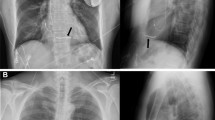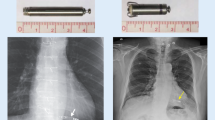Abstract
A counterpulsation device (Symphony) that works synchronously with the native heart to provide partial circulatory support was developed to treat patients with advanced heart failure. Symphony is implanted in a ‘pacemaker pocket’ without entry into the chest, and requires timing with ECG for device filling and ejection. Surface leads are limited to short-term use due to signal distortion and lead management issues. Transvenous leads are a clinical standard for pacemakers and internal defibrillators, but increase the complexity of the implant procedure. In this study, the feasibility of using subcutaneous leads for synchronized timing of Symphony was investigated. ECG waveforms were simultaneously measured and recorded using epicardial (control) and subcutaneous (test) leads in a bovine model for 7-days (n = 6) and 14-days (n = 2) during daily activity and treadmill exercise. Landmark features and R-wave triggering detection rates for each lead configuration were calculated and compared. Lead placement, migration, durability, and infection were quantified using fluoroscopy and histopathological examination. There were 2,849 data epochs (30-s each) recorded at rest (133,627 analyzed beats) and 35 data epochs (20 min each) recorded during treadmill exercise (37,154 analyzed beats). The subcutaneous leads provided an accurate and reliable triggering signal during routine daily activity and treadmill exercise (99.1 ± 0.4% positive predictive value, 96.8 ± 1.5% sensitivity). The subcutaneous leads were also easily placed with minimal lead migration (0.5 ± 0.1 cm), damage (no fractures or failures), or infection. These findings demonstrate the feasibility of using subcutaneous leads for synchronized timing of mechanical circulatory support while offering the advantage of less invasive surgery and associated risk factors.





Similar content being viewed by others
References
Bardy, G. H., et al. An entirely subcutaneous implantable cardioverter-defibrillator. N. Engl. J. Med. 363(1):36–44, 2010.
Bartoli, C. R., et al. A novel subcutaneous counterpulsation device: acute hemodynamic efficacy during pharmacologically induced hypertension, hypotension, and heart failure. Artif. Organs. 34(7):537–545, 2010.
Bellardine, B., et al. Is surface ECG a useful surrogate for subcutaneous ECG? Pacing Clin. Electrophysiol. 33(2):135–145, 2010.
Drew, G., and S. Koenig. Biomedical patient monitoring, data acquisition, and playback with LabVIEW. In: Virtual Bio-Instrumentation: Biomedical, Clinical, and Healthcare Applications in LabVIEW, edited by J. B. Olansen, and E. Rosow. Upper Saddle River, NJ: Prentice Hall, 2002, pp. 180–186.
Fotuhi, P., et al. R wave detection by subcutaneous ECG. possible use for analyzing R R variability. Ann. Noninvas. Electrocardiol. 6(1):18–23, 2001.
Frankel, R. A., et al. A filter to suppress ECG baseline wander and preserve ST-segment accuracy in a real-time environment. J. Electrocardiol. 24(4):315–323, 1991.
Giridharan, G. A., et al. Predicted hemodynamic benefits of counterpulsation therapy using a superficial surgical approach. ASAIO J. 52(1):39–46, 2006.
Gomes, J. A., et al. Optimal bandpass filters for time-domain analysis of the signal-averaged electrocardiogram. Am. J. Cardiol. 60(16):1290–1298, 1987.
Grace, A., et al. Evaluation of four distinct subcutaneous implantable defibrillator (S-ICD®) lead systems in humans. Heart Rhythm 3:S128–S129, 2006.
Hanlon-Pena, P. M., and S. J. Quaal. Intra-aortic balloon pump timing: review of evidence supporting current practice. Am. J. Crit. Care 20(4):323–333, 2011.
Hassler, C. ECG lead placement in quadrupeds. Telemetry Times (Technical Note, 8/3/94). Data Sciences Int, 1994.
Ho, C., and S. Kurtzman. Three perspectives of cardiac electrical activity. Biomed. Sci. Instrum. 37:325, 2001.
Iglesias, J. F., et al. The implantable loop recorder: a critical review. Kardiovaskuläre Medizin 12(3):85–93, 2009.
Kautzner, J., et al. Technical aspects of implantation of LV lead for cardiac resynchronization therapy in chronic heart failure. Pacing Clin. Electrophysiol. 27(6p1):783–790, 2004.
Koenig, S. C., et al. Integrated data acquisition system for medical device testing and physiology research in compliance with good laboratory practices. Biomed. Instrum. Technol. 38(3):229–240, 2004.
Koenig, S. C., et al. Development and early testing of a simple subcutaneous counterpulsation device. ASAIO J. 52(4):362, 2006.
Koenig, S. C., et al. Acute hemodynamic efficacy of a 32-ml subcutaneous counterpulsation device in a calf model of diminished cardiac function. ASAIO J. 54(6):578, 2008.
Lawton, J. S., et al. Sensing lead-related complications in patients with transvenous implantable cardioverter-defibrillators. Am. J. Cardiol. 78(6):647–651, 1996.
Lobodzinski, S. S., M. M. Laks, S. S. Lobodzinski, and M. M. Laks. Comfortable textile-based electrocardiogram systems for very long-term monitoring. Cardiol. J. 15(5):477, 2008.
Meyns, B., et al. Proof of concept: hemodynamic response to long-term partial ventricular support with the synergy pocket micro-pump. J. Am. Coll. Cardiol. 54(1):79–86, 2009.
Nanas, J. N., and S. D. Moulopoulos. Counterpulsation: historical background, technical improvements, hemodynamic and metabolic effects. Cardiology 84(3):156–167, 1994.
Pantalos, G. M., S. C. Koenig, K. J. Gillars, G. S. Haugh, R. D. Dowling, and L. A. Gray. Intraaortic balloon pump timing discrepancies in adult patients. Artif. Organs. 35(9):857–866, 2011.
Papaioannou, T. G., and C. Stefanadis. Basic principles of the intraaortic balloon pump and mechanisms affecting its performance. ASAIO J. 51(3):296–300, 2005.
Pino, E., et al. Real-time ECG Algorithms for Ambulatory Patient Monitoring. 2005. American Medical Informatics Association.
Schreuder, J. J., et al. Beat-to-beat effects of intraaortic balloon pump timing on left ventricular performance in patients with low ejection fraction. Ann. Thorac. Surg. 79(3):872–880, 2005.
Schwartzman, D., et al. Postoperative lead-related complications in patients with nonthoracotomy defibrillation lead systems. J. Am. Coll. Cardiol. 26(3):776–786, 1995.
Thakor, N. V., J. G. Webster, and W. J. Tompkins. Estimation of QRS complex power spectra for design of a QRS filter. IEEE Trans. Biomed. Eng. (11):702–706, 1984.
Acknowledgments
This study was funded by NIH SBIR phase I grant 1R43HL102981-01. Funding was provided to SCR (Louisville, KY) and the University of Louisville by NIH-SBIR phase II (R43HL102981) and Kentucky Science & Technology (KSTC-184-512-08-054) grants.
Disclosures
Landon Tompkins, Robert Dowling, MD and Paul Spence, MD are employees of SCR Inc (Louisville, KY) with commercial interests in the development of the Symphony system. Eric Gratz is an employee of Abiomed Inc (Danvers, MA) with commercial interests in the development of the Symphony system.
Author information
Authors and Affiliations
Corresponding author
Additional information
Associate Editor W. Robert Taylor oversaw the review of this article.
Rights and permissions
About this article
Cite this article
Warren, S., Giridharan, G.A., Dowling, R.D. et al. Feasibility of Subcutaneous ECG Leads for Synchronized Timing of a Counterpulsation Device. Cardiovasc Eng Tech 3, 17–25 (2012). https://doi.org/10.1007/s13239-011-0074-2
Received:
Accepted:
Published:
Issue Date:
DOI: https://doi.org/10.1007/s13239-011-0074-2




